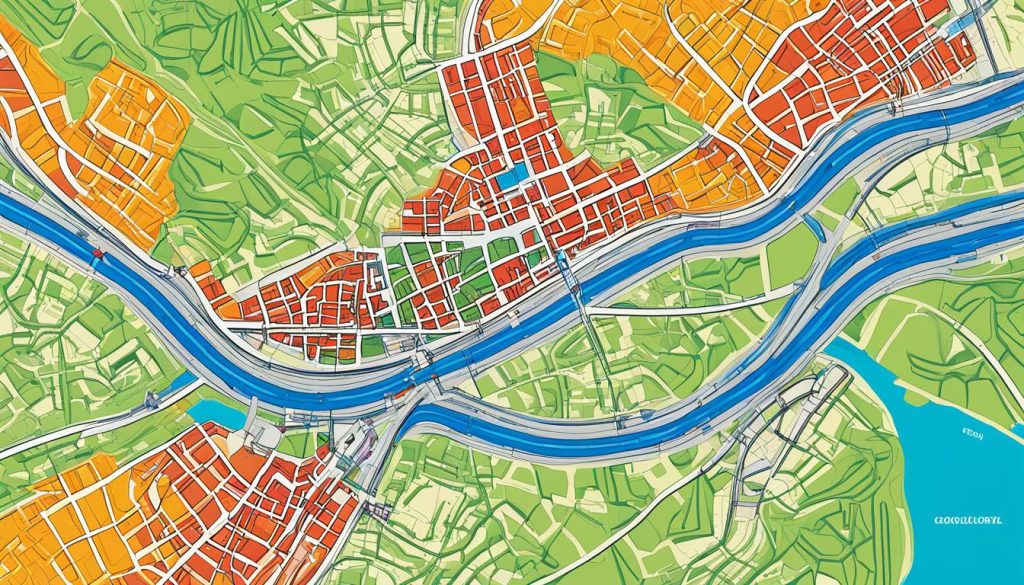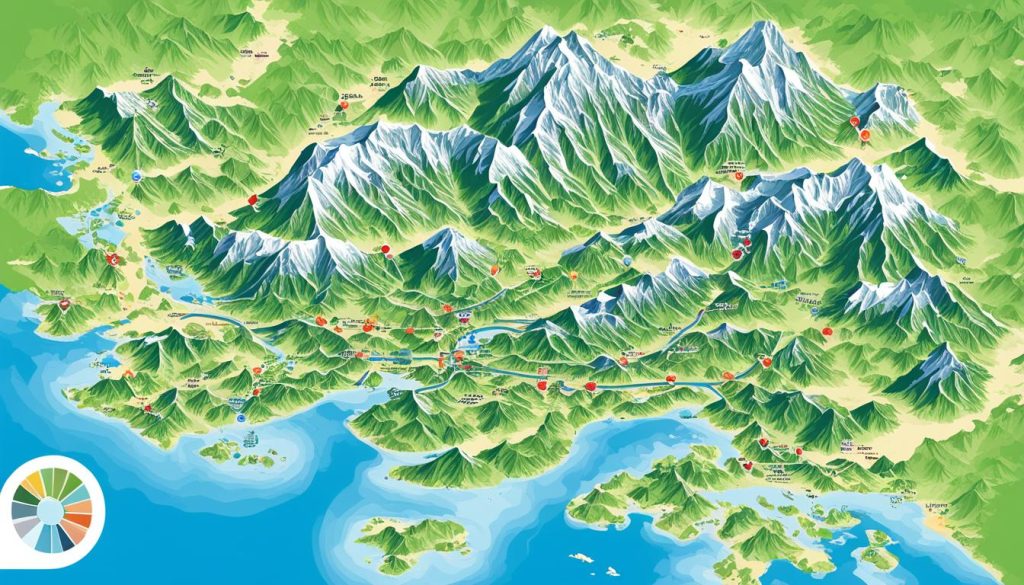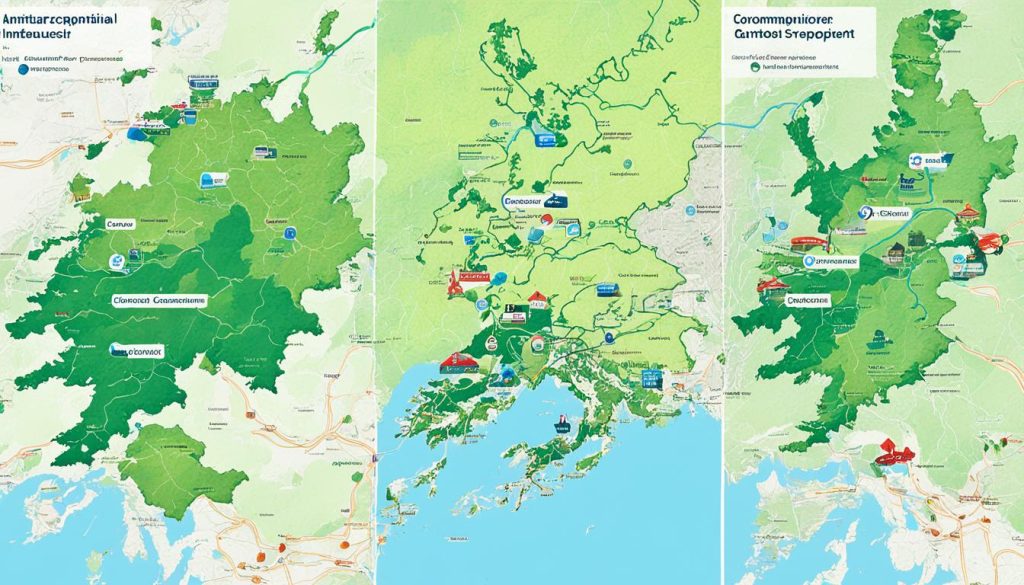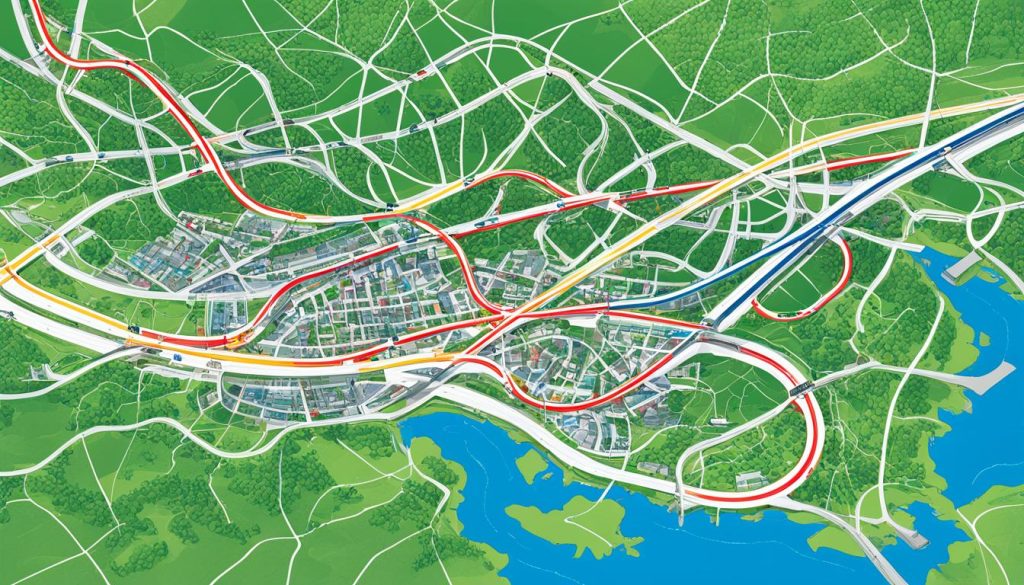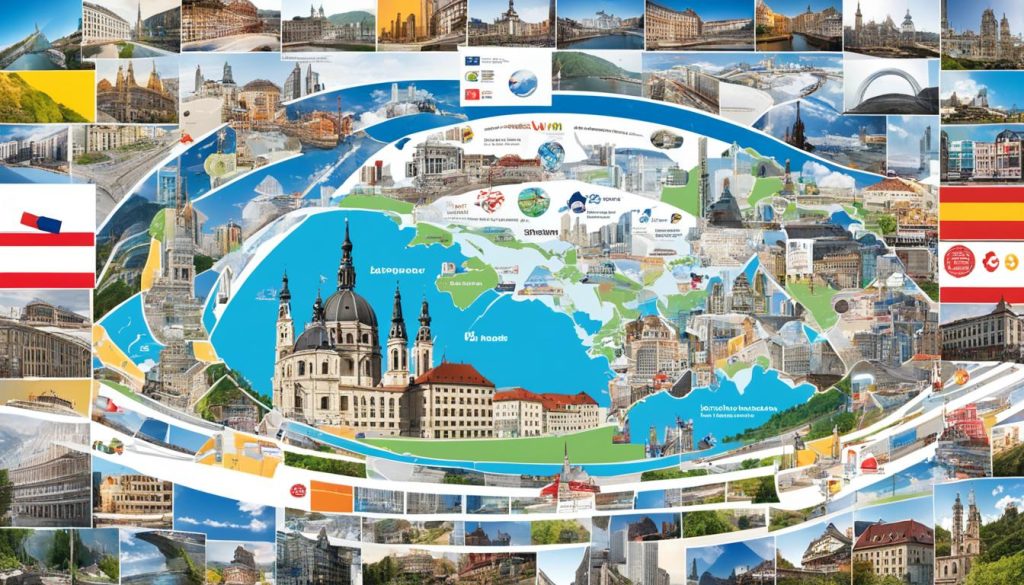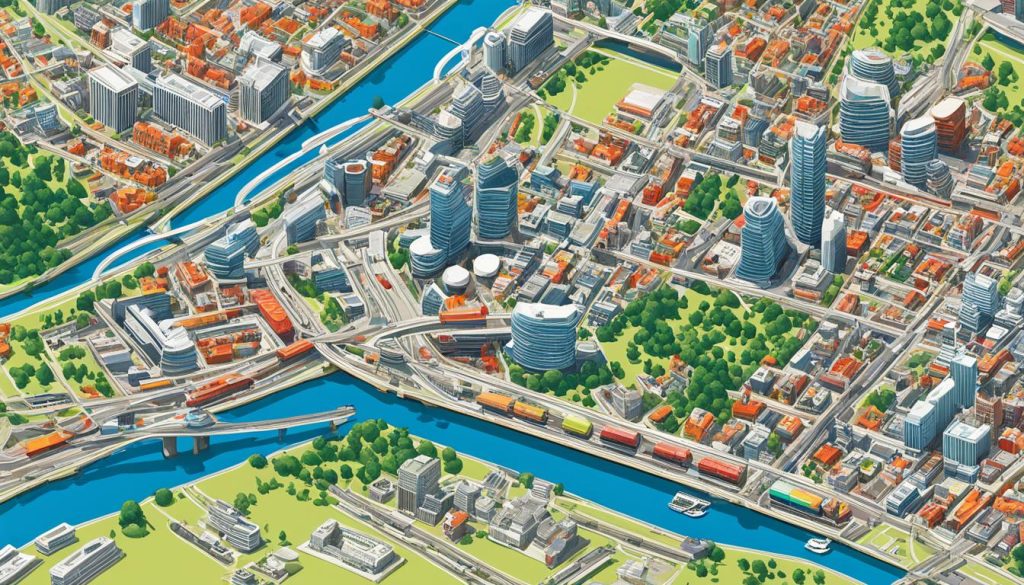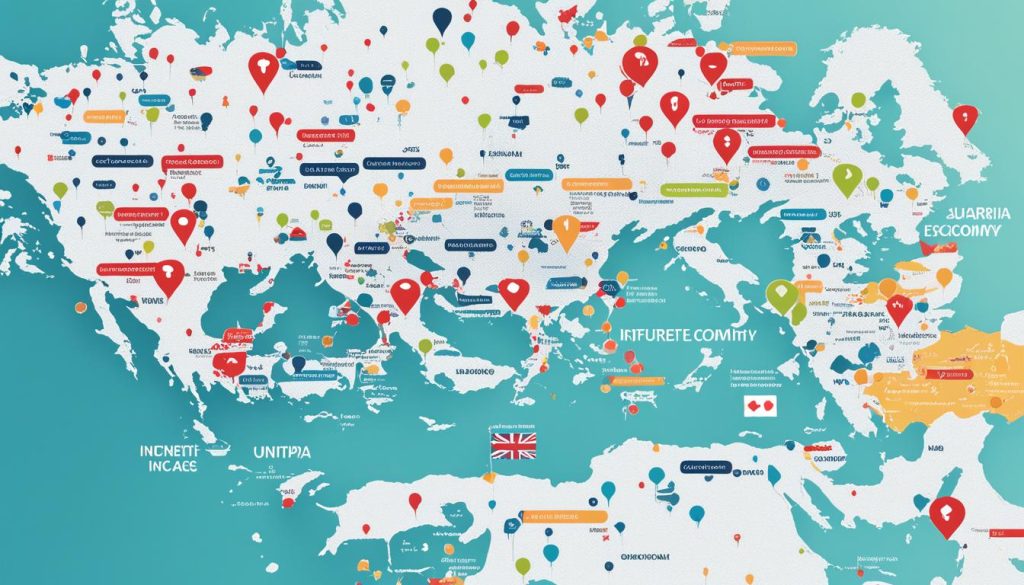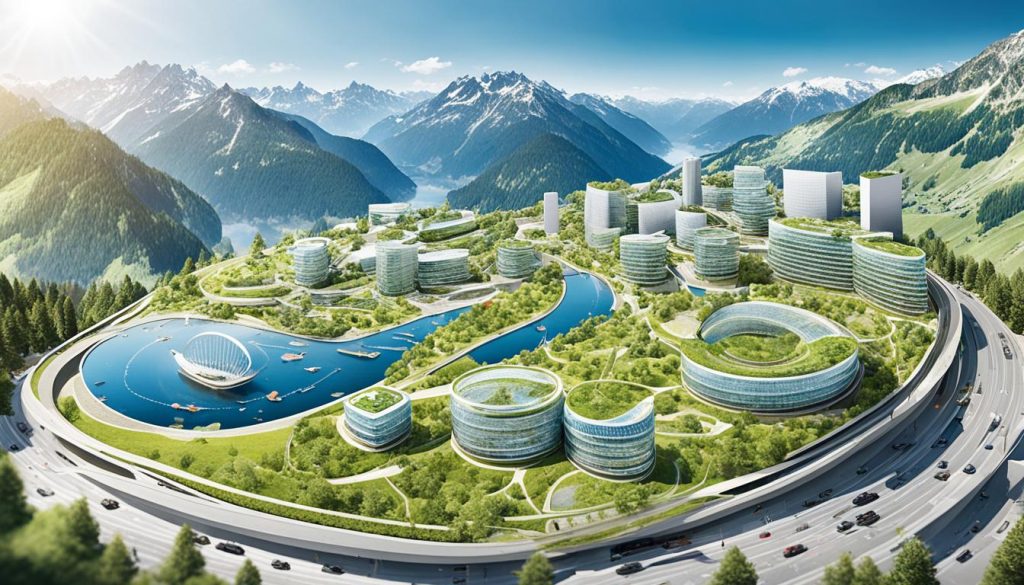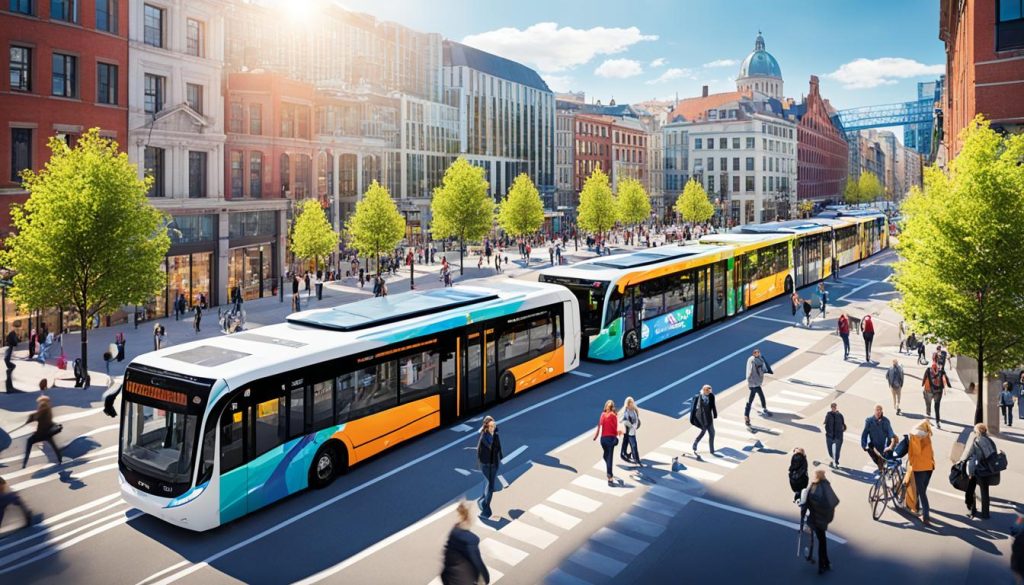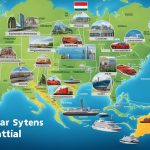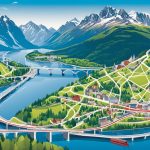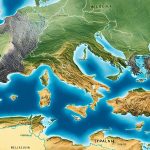A look at Austria, the UK, and Japan shows how geography and infrastructure shape a nation’s growth. These countries turn their geographical features into assets. Austria uses its mountains to enhance its transport, the UK builds on its economic strength, and Japan’s innovation shines.
Understanding the link between geography and infrastructure is key. It helps us find ways to grow sustainably and improve our lives. By studying these countries, we learn how their natural and built worlds come together to face challenges and achieve goals.
Geographical Perspectives: Austria, UK, and Japan
Looking at Austria, the UK, and Japan, we see how their weather, land, and natural beauty are unique. We compare how their landscapes support the people and use of land resources. This helps us understand how geography shapes their societies and economies.
Diverse Climate and Terrain: An Analysis
The climates in Austria, the UK, and Japan vary greatly. Each place faces different challenges based on its climate. For example, Austria has cold winters ideal for skiing, the UK’s green lands thrive in a mild climate, and Japan has a mix of climates from snow to tropical.
- Alpine challenges and ski-tourism in Austria’s high-altitude resorts
- Maritime moderations affecting agricultural practices in the UK
- Subtropical opportunities and typhoon threats along Japan’s Pacific fringe
Comparative Land Area and Population Distribution
Japan, Austria, and the UK have different sizes and population layouts. Japan has busy cities, while Austria’s population is more spread out. This shows how land affects people’s lives and culture.
- Land area: Japan > UK > Austria
- Urban concentration in Japan resulting in mega-cities
- Austria’s balanced population spread enabling wide-ranging rural development
Unique Geographic Traits and Natural Resources
Looking at their natural resources, we see how geography benefits or challenges these countries. Austria is known for its forests, the UK for its oil and wind energy, and Japan uses innovative methods to get minerals from the sea.
- Austria’s timber and hydropower reservoirs
- UK’s exploitation of fossil fuels juxtaposed with its wind energy surge
- Japan’s quest for deep-sea resources complementing its technological prowess
The geography of Austria, the UK, and Japan tells a story of how landscapes impact nations. Their climates, terrains, and resources play vital roles in their economic and social lives.
Economic Indicators and Infrastructure Development
Modern economies depend a lot on economic indicators and infrastructure growth. Looking at how these elements work together in different countries tells us how economies grow and stay strong. For example, Austria, the UK, and Japan show how a country’s location affects its economy.
Influence of Geography on Economic Growth
Geography greatly affects how well an economy does. This is clear when comparing the GDP per capita of countries like Austria and Japan. Austria benefits from its central European location, which boosts its economy with strong infrastructure. This shows how important it is to use the natural and strategic benefits of a region.
Public Debt and its Impact on Infrastructure Investment
Public debt is key to deciding how to invest in infrastructure. Look at Austria and Japan, and you’ll see big differences in their public debt levels. This not only shows how healthy an economy is but also affects decisions on infrastructure projects. These projects are vital for keeping an economy strong over time.
- GDP per capita and other economic indicators highlight how geography and infrastructure affect economies differently.
- Handling public debt well is important for ongoing infrastructure investments, essential for growth and modernisation.
- Infrastructure growth reflects not just economic power but also the benefits of a good location and smart policies.
It’s crucial to understand economic indicators, geography, and public debt for good infrastructure investment plans. These plans help societies grow and succeed in the global economy.
Transport Infrastructure: Facilitating Economic Progress
Transport infrastructure is crucial for improving a nation’s economy and its global trade position. By investing in roads and modernising them, countries like Austria, the UK, and Japan boost their trade. These improvements support not just today’s trade but also future growth in the global market.
Road Networks and Position in Global Trade
Road networks are vital for economic activity. They help in the efficient transport of goods and services. Austria links Eastern and Western Europe, the UK boasts vast motorways, and Japan has advanced expressways. These countries know good roads are key to staying competitive in global trade.
Investing in Transport for Future Sustainability
To prepare a better world for the next generations, these nations focus on sustainable transport. They are leading in adopting green practices in transport. This includes electric public transport and smart infrastructure. Their efforts aim at sustainable development and a strong economy after the pandemic.
- Advancements in road safety and reduction in traffic congestion
- Integration of environment-friendly public transportation options
- Commitment to ongoing maintenance and technological upgrades
The Crucial Role of Education in National Development
Educational investment shapes societies. Nations dedicate part of their GDP to upbringing young minds. This is key to building a strong workforce that keeps up with global changes.
Looking at educational spending shows how it boosts national wealth and progress. There’s a clear link between what countries spend on education and how long kids stay in school. This affects a country’s future success.
Education Expenditure as a Percentage of GDP
Governments spend on education to drive growth. This spending, shown as a share of GDP, reveals how much they value education. Austria, for example, spends 5.5% of its GDP on education. This shows they really focus on learning and building human talent.
School Life Expectancy and Future Workforces
School life expectancy tells us about a country’s future workers. Austria’s kids are in school for 16 years, Japan’s for 15. Longer school time means better skills and knowledge for jobs and progress. It’s key for adapting to new job markets.
- Education’s role in providing sustainable skill sets for emerging industries is fundamental.
- National development is invariably linked to the intellectual capacity of a country’s population.
- An analysis of education expenditure offers insight into a nation’s foresight and investment in its own future.
- GDP serves as a clear indicator of a government’s valuation of education within its wider economic strategy.
- School life expectancy stands as a predictor for a nation’s potential to foster a well-informed and capable workforce.
Healthcare Infrastructure: Comparing Access and Quality
Talking about healthcare infrastructure is key in looking at a nation’s health. There’s a clear connection between the healthcare resources available, like hospital beds, and how effective the health system is. To compare healthcare access and quality, we look at important indicators. These include life expectancy and how many hospital beds are available. These factors show us a lot about the healthcare services people receive.
Hospital Beds Availability and Healthcare Provisions
In comparing Japan and Austria, the difference in their healthcare infrastructures is clear. Japan has a stronger healthcare system, shown by its higher number of hospital beds per person. It has an impressive 13.4 beds per 1,000 people, much more than Austria’s 7.6. This difference highlights how each country can meet its healthcare needs. Having enough hospital beds is key in facing medical emergencies and in giving routine care.
Life Expectancy as an Indicator of Health Systems’ Effectiveness
Life expectancy is a great way to see how good a health system is. Japanese women have one of the highest life expectancies in the world, at 89 years. Austria’s is also high but a bit lower, at 84.5 years. These numbers show how well healthcare infrastructure supports long life. They also stress the importance of having access to good healthcare. Plus, they show us how investing in healthcare infrastructure can improve people’s health.
With the right infrastructure, countries can give better care, improve health, and increase life expectancy. So, the comparison between Japan and Austria not just measures their infrastructure. It also starts a discussion on making health systems work well for everyone.
Urbanisation and Housing: Patterns Across Three Nations
Urbanisation brings new styles to housing, with Austria, the UK, and Japan each showing unique approaches. In Japan, cities are bustling hubs and densely filled, leading to a rise in vertical living solutions. The UK is changing old industrial sites into places where people can live and work. This meets the needs of its growing city populations. Austria finds a middle ground, mixing traditional city life with peaceful suburban areas.
In these countries, building homes is closely tied to creating sustainable cities. They are focusing on new ways to build, improving public services and connecting areas with good transport. This helps manage the increase in city dwellers.
- Japan promotes living in compact apartments with clever designs to use small spaces well. This approach suits its large population.
- The UK is making its city centres lively again. New developments are places where people can live, work, and relax together.
- Austria focuses on energy-saving buildings and keeping green spaces in cities. This shows they know how important nature is for city life.
The stories of urbanisation in these three nations show how vital housing is to a society’s health and cities’ growth. Creating spaces that offer more than just a place to stay, but also opportunities to enjoy life, is essential. This approach meets the modern needs of urban development.
Technology and Connectivity: Internet Access and Digital Infrastructure
Exploring technology and connectivity highlights the importance of internet access. It’s crucial for modern societies. Investing in strong digital networks supports the digital economy and sparks innovation. Countries like Austria and Japan are enhancing their tech capabilities. This boosts their position in the global economy and their potential for innovation.
Percentage of Internet Users and Digital Economy Potential
In Austria, 93% of people have internet access, showing nearly everyone is connected. Japan follows closely, with 83% of its residents online. This wide internet access helps them jump into the digital economy. It opens doors for growth and innovation. This change affects businesses, schools, and government services greatly. It blends with traditional economic sectors to make society more connected and efficient.
Impact of Technological Infrastructure on Innovation
The base of digital change is strong and resilient digital infrastructure. Solid technological setups ensure smooth connectivity. They also help create a perfect environment for innovation. Both new tech startups and big companies benefit from this. Having strong infrastructure is key to competing globally. Thus, Austria and Japan are investing in these vital areas. They are becoming leaders in the global digital economy.
Environmental Sustainability and Green Infrastructure
Environmental sustainability is now a key goal globally. Austria and Japan lead in mixing green infrastructure with urban plans. They show deep care for the environment and sustainable growth. They focus on increasing forests and using renewable energy.
Forest Cover Percentage and Environmental Policies
Austria’s forests cover 47.2% of its land, highlighting its commitment to green spaces. Japan’s 68.5% forest cover not only adds to its beauty. It shows its focus on conservation and biodiversity.
- Strategies aimed at preserving natural habitats
- Legislation promoting sustainable forest management
- Commitments to international agreements on deforestation and climate change
Renewable Energy Adoption in Urban Planning
Now, urban planning always includes renewable energy for future cities. Austria and Japan are front-runners, with plans that boost renewable energy for growing cities.
- Incorporation of solar and wind energy in cityscapes
- Development of smart energy networks
- Investment in research for innovative green technologies
Both countries aim for a world where cities and nature coexist peacefully. Their rich forests and renewable energy in cities set a standard. Their actions inspire global moves toward environmental sustainability and green infrastructure.
Public Transportation Networks: Efficiency and Expansion
Public transport systems play a key role in the life of cities. As cities grow, these networks lead in making travel efficient and expanding transport options. The COVID-19 crisis has brought new challenges. It has sparked major investment in infrastructure to improve and adapt public transport.
Role of Public Transport in Urban Commuting
Public transport is vital for city travel, offering a green alternative to cars. It’s not just about ease but is key for sustainable cities. Recently, there’s been a push to make transport more connected, ensuring it’s accessible to everyone. Changes like more frequent services and better digital tools are helping make travel easier.
Infrastructure Investment Responding to COVID-19
During the pandemic, public transport had to change to keep users safe and support public health. Investments focused on allowing social distancing and enhanced cleaning. Additionally, the crisis accelerated the use of touchless payments and smart systems to manage crowds, showcasing the impact of smart design in transport.
- Increased frequency of deep cleaning regimes within public transport vehicles and terminals
- Development of advanced air filtration systems to maintain high air quality standards
- Upgrades to existing infrastructure to facilitate smoother and safer passenger movement
- Greater focus on real-time data to enable dynamic management of passenger volumes
Together, these actions show a big change in how we view public transport, with a new focus on health, safety, and readiness for future challenges.
Trade and Transport: Ports and Connectivity on a Global Scale
Trade and transport play a huge role in a country’s economy. Nations that focus on their ports and global links do better in the world of trade. They fit well into the global trade network.
Austria connects Eastern and Western Europe, despite having no sea access. It boosts its trade by developing railways and roads. This improves its transport and helps overcome being landlocked, making it key in global trade.
-
Development of dry ports for intermodal connections
-
Expansion of trans-European transport networks
-
Initiatives for sustainable freight transport
The UK and Japan, surrounded by sea, have made the most of their location. The UK’s maritime trade has grown from its naval past, with ports like Southampton leading. In Japan, ports like Yokohama play a big part in its trade efforts.
-
Enhancements in port technology to streamline cargo handling
-
Upgrading port infrastructure to accommodate larger vessels
-
Strategic alliances in global shipping networks
Working on better trade and global connections is key for the economy. It needs careful planning and strong international relationships. This supports global trade big time.
Impact of Agriculture and Land Use on National Economies
Agriculture and land use deeply affect the economy, especially in rural areas. In countries like Austria, the UK, and Japan, farming is key to the well-being of countryside communities. It also boosts the overall economy. Getting to grips with how land use changes impact economies is vital.
In Austria, the link between farming, tourism, and taking care of the environment helps the economy and rural areas grow. The UK focuses on farming that respects the environment and tries new ways to make money from the land. Facing a shortage of farming land, Japan uses tech to get the most out of it. All three countries understand that their farming policies need to keep up with modern needs while protecting the environment for the future.
- Exploration of the Austrian model highlighting synergies between agriculture, tourism, and conservation.
- Assessment of the UK’s strategies for sustainable agriculture and rural economic diversification.
- Insight into Japan’s technological advancements in agriculture and its approaches to maximise land use efficacy.
Land use also touches the national economy through the complex world of food supplies, jobs, and trade policy. It’s key to the growth of rural areas, which depend on smart land management and forward-thinking agricultural policies.
- The role of agriculture in food security and its broader economic implications.
- Agriculture’s contribution to employment and how it shapes workforce dynamics in rural sectors.
- Land use policy’s influence on trade and how it forms part of national and international economic strategies.
Looking forward, it’s clear that choices about land use today will shape our future. They affect not just the economy, but also how well rural communities can thrive. Every policy tweak, each new farming technique, and every effort towards lasting rural prosperity is a step towards ongoing economic stability and growth.
A Comparative Assessment of Quality of Life Indicators
Analyzing how different countries fair in quality of life helps us understand what makes societies happy. The World Happiness Report is key for this. It shows the happiness levels in countries and links them to their wealth, community, and government. When looking at Austria, the United Kingdom, and Japan, it’s clear that happiness comes from many sources. These include the country’s wealth and how people view their government’s honesty.
World Happiness Report and GDP’s Role in Life Satisfaction
The World Happiness Report shows that richer countries often have happier people. But money alone doesn’t bring happiness. Being supported by others, having the freedom to choose your life, and kindness matter too. Austria, the UK, and Japan are wealthy. But their people’s happiness also depends on more than just money.
- Wealth matters, but so do support from others and freedom.
- The culture and values of a place also affect happiness and wealth.
Corruption Perception and its Influences on Societal Well-being
How people view corruption affects quality of life too. If governance is seen as transparent, people tend to trust more. This trust boosts society’s well-being. Less corruption means more trust, which leads to a better life for everyone.
- Looking at corruption indexes shows how important good governance is to people’s spirits.
- In Austria, the UK, and Japan, views on corruption influence how content people feel.
Financial Allocation and Investment in Infrastructure
In national development, splitting funds between maintaining current infrastructure and starting new projects is crucial for governments. This balance highlights a nation’s immediate and future goals. Austria, the United Kingdom, and Japan demonstrate different methods of balancing these priorities, each adapting to their own economic and structural needs.
Analyzing Budget Prioritisation for Infrastructure Projects
Different countries have varied approaches to budgeting for infrastructure. The United Kingdom often leads in investing in big projects that improve connections and boost the economy. On the other hand, Austria prefers a balanced approach. It mixes maintenance with cautious growth, focusing on keeping existing assets in good condition.
Maintenance Spending Versus New Infrastructure Investment
Japan provides a unique look into this balance. It juggles the needs of an aging population and the need for disaster readiness. Japan invests in advanced infrastructure while maintaining its vast assets. This shows its commitment to innovation and long-term viability.
To conclude, these approaches highlight how infrastructure plays a role in national success. Whether it’s investment, budgeting, or maintenance, these actions are key to the growth of Austria, the UK, and Japan. By smartly choosing where to spend, these countries aim for continuous development and better public services.
